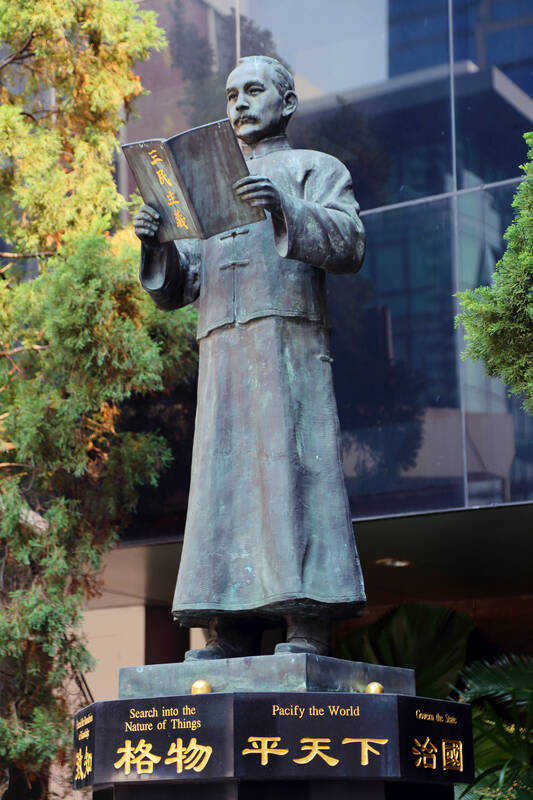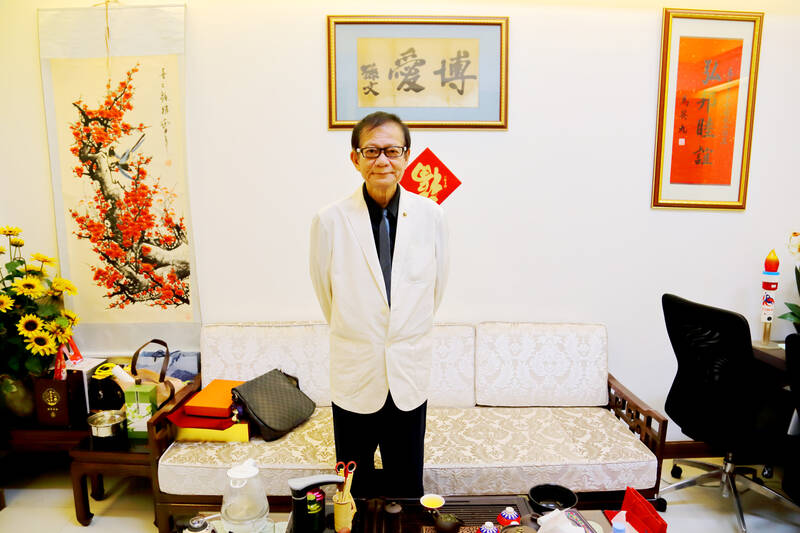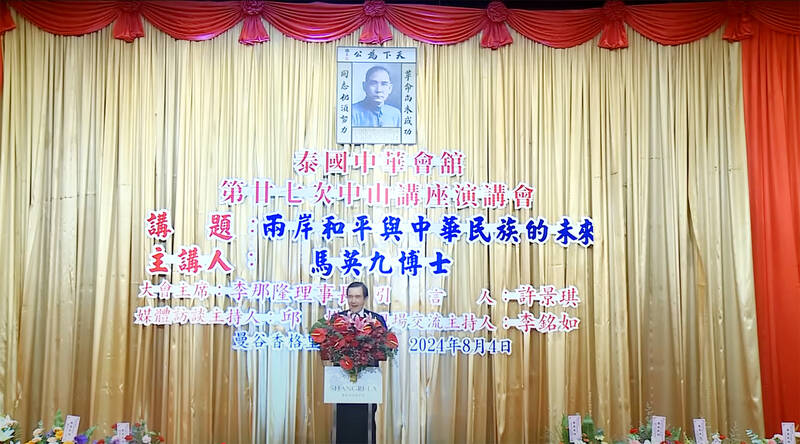In 1907, four years before the fall of the Qing Dynasty, Sun Yat-sen (孫逸仙), the leader of China’s republican movement, organized Thailand’s overseas Chinese into a secret society to support his mounting revolution. The society, initially named the “Chinese Club” or Chunghua Huisuo (中華會所), outwardly functioned as a chamber of commerce. But secretly, it also provided cover for a branch of Sun’s political organization, the Tongmenghui (同盟會), through which overseas Chinese funded armed uprisings against the Manchu emperor.
After Sun declared the establishment of the Republic of China (ROC) on Jan. 1, 1912 in Nanjing, the Tongmenghui transformed itself into the Chinese Nationalist Party (KMT), and Bangkok’s “Chinese Club” formalized its status as the Chung Hua Association (中華會館).
Today, Thailand’s oldest bastion of Chinese republicanism, located in a glass and marble 1990s-government-style building in Bangkok’s Sathorn District, is still, according to its current chairman Chen Hong-zhang (陳鴻彰), the longtou (龍頭) — literally the “dragon’s head,” or senior leader — “of Thailand’s overseas Chinese community.”

Photo: David Frazier
“Almost all the organizations by overseas Chinese groups here have branched out from us,” said Chen, speaking to me in March in his Bangkok office.
Thailand is home to the world’s largest population of overseas Chinese, estimated to comprise between 11 to 14 percent of the kingdom’s 71 million people.
Most are fully assimilated, using Thai names and unable to speak Chinese. But to some, preserving their Chinese cultural heritage and language is crucial, so links to Han-majority societies are very important. In the Chung Hua Association’s case, this means Taiwan.

Photo: David Frazier
Chen, whose legal Thai name is Rabu Tangthongtavee, is a real estate developer, a slight man with an assertive voice and a head of wispy gray hair. In the association’s directory, a long list of credentials follow his name — honorary chairmanships to five separate alumni organizations, including those for graduates of Taiwanese universities, Chinese-language universities and the Whampoa Military Academy (established by the KMT in 1924 in China, it exists today as Taiwan’s version of West Point), director and CEO of the Federation of Overseas Chinese in Thailand, chairman or CEO of three separate businesses and owner of an apartment complex in the Bangkok suburb of Samut Prakan.
Greeting me in a crumpled cream blazer, Chen welcomed me into his office, a bright, spacious room, its walls hung with a brush painting of plum blossoms, a portrait of Sun Yat-sen, and two prominent works of calligraphy. One is from the brush of Sun Yat-sen himself, Bo Ai (博愛 “universal love”), a phrase Sun often inscribed as a gift. The other, a four-character phrase on festive red paper, was by former president Ma Ying-jeou (馬英九), given just last year after delivering a keynote address at the association’s annual Sun Yat-sen lecture series.
‘STRONG TAIWAN CONNECTIONS’

Youtube screen grab
Sitting down on an embroidered white sofa, Chen told me he’d just returned from a three-day trip to Taiwan, then began pouring tea into cups bearing the design of the ROC flag.
“Our association has a 117-year history in the Thai overseas Chinese community,” he began, speaking with visible pride. “It is an independent organization. It is not from Taiwan. No organization in Taiwan sponsors us, supports us or funds us.”
“But most of our members have strong Taiwan connections,” he continued. “They can speak Chinese because they went back to Taiwan to study when they were young. I am an example. I went to Taiwan to study when I was nine years old.”
Chen, who is fourth generation Teochew, his great-grandfather an immigrant from Raoping, Guangdong, began his schooling in Taiwan from the first grade. It was only upon graduation from Feng Chia University in Taichung that he returned to Bangkok to start his career.
Like most Thai-Chinese of the Cold War generation, he grew up looking to Taiwan as the major source of his Chinese identity. But in the last two decades, with the growth of the Taiwanese identity movement and China’s growing influence in southeast Asia, he’s witnessed “a division between the left and the right in Thailand’s overseas Chinese communities,” he said.
By “left” he meant China and by “right” he meant Taiwan.
“Many overseas Chinese groups,” he continued, “are now leaning towards that side,” he added, indicating China.
But the Chung Hua Association, he insisted, is one of Thailand’s few Chinese organizations that have managed to straddle the divide. Personally, he said, he maintains solid connections to both the Chinese Embassy and the Taipei Economic Cultural Office in Thailand, Taiwan’s de facto embassy. But “many Thai-Chinese feel the Chung Hua Association is Taiwanese, so they won’t associate with us.”
The association also has varying relations with the KMT and the Democratic Progressive Party (DPP).
“If the KMT is in power, then our relationship with the Republic of China will be particularly close. But if the Democratic Progressive Party is in power, it will be” — here Chen paused before completing the thought — “more distant.”
THE SCHOOL
At present, the Chung Hua Association operates one of the last Chinese-language schools in Bangkok that teaches using traditional Chinese characters. Two or three decades ago, traditional characters were standard in most of Thailand, said Chen, but most schools have now switched to the PRC system of simplified characters.
This shift has accelerated since the 2006 launch of China-sponsored Confucius Institutes in Thailand — the same year that China began funding schools in Thailand’s Yunnan villages, which are populated by descendants of Chiang Kai-shek’s (蔣介石) armies.
Thailand now has at least 28 Confucius Institutes — embedded in high schools and universities, they have been heavily criticized as instruments of Chinese Communist Party ideology and are all but banned in the US — the second-most in Asia behind South Korea
But as one of Thailand’s last bastions of traditional Chinese, the Chung Hua school looks to Taiwan for education.
The school currently has around 1,200 students between the ages of 14 and 25, and all of the school’s 36 teachers are Taiwanese. The school also administers Taiwan’s government standard proficiency tests for Mandarin Chinese and organizes month-long educational exchanges to Taiwan’s universities in coordination with Taiwanese government agencies, including the Overseas Community Affairs Council (OCAC) and Ministry of Education.
SUN WORSHIP
The preservation of Sun Yat-sen Thought (國父思想) is another of Chung Hua’s core mandates, Chen said.
Sun is considered the “National Father” in Taiwan and the “Forerunner of the Revolution” in China. Many on both sides of the Taiwan Strait view him as a potential bridging figure in their otherwise divided histories.
Large portraits of Sun grace the association’s grandiose 300-seat capacity meeting hall, conference rooms and chairman’s office. An impressive bronze statue of Sun, saintly and in long scholarly robes, stands outside the main entrance, its octagonal pediment inscribed with quotations and virtues Sun advocated.
Sun’s history in Thailand is preserved in a small museum on the association’s first floor, a mausoleum-like time capsule of ROC nostalgia. Exhibits in two long hallways consist of curling black and white photographs and lengthy wall texts detail the parallel tracks of the association’s history and the early days of China’s republican movement. Chin Ya-tsao (覃亞操), a humble and affable 79-year-old who is the Chung Hua Association’s director general, switched on the lights before leading me in.
The history preserved here, said Chen, consists of three important stages. First was the Association’s establishment, which required Sun to perform the impressive feat of uniting Bangkok’s diverse Chinese factions of Cantonese, Teochew, Hainanese and Hakka.
The second state was “the revolution to save the country” — the 1911 Xinhai Revolution that overthrew the Qing Dynasty — ”which everyone supported through donations.”
Third was “the War of Resistance against Japan.”
In these defining movements of modern Chinese history, Chen solemnly declared, “We at the Chuang Hua Association did not fail to participate in any of them.”
In the fight against the Qing, a Chung Hua Association member, Chou Hua (周華), is listed among the 72 martyrs of the Huanghuagang Insurrection of 1911, an important precursor to the successful Wuchang uprising, which effected the downfall of the Qing and is now remembered as the ROC’s National Day.
In the 1920s, the Association “sent patriots to Whampoa Military Academy,” said Chen. It also purged communists from its ranks.
In the war against Japan, “We sent around 2,000 soldiers to fight,” Chin said, “but only around 200 of them came back.”
Oddly, the museum’s history mostly ends around 1949, which marked the end of the Chinese Civil War and the split between Taiwan and China. When I asked Chin if there was any post-1949 ROC history, he scanned the galleries for a moment, then pointed to several black-and-white photos of KMT soldiers performing military drills.
“I think these are from Taiwan,” he said.
DOUBLE TEN IN 1950
The Chung Hua Association was briefly forced to go underground during World War II, when Japan fought against China and asserted political control in Thailand. Following the war’s end, the body quickly reorganized and officially incorporated in 1947.
In 1949, during the wake of the Chinese Civil War, Thai-Chinese were split between pro-PRC and pro-KMT factions. Maoists smeared Chung Hua members as “white Chinese” (白華) and menaced some with extortion.
But the Association, in its official history, which even today reproduces the language of the 1950s, struck a defiant tone: “Although the Communists spread rumors and routinely act with great arrogance, they cannot shake us…. We are absolutely certain that so-called communism and socialism are unworkable and without substance. We believe that the Chinese Communist Party is bound to fail within a few years.”
In 1950, the Association celebrated the ROC National Day, the first following the Chinese Civil War, with intense relief and fanfare.
“We celebrated our Double Tenth National Day with tears in our eyes,” the history reads, and “rented the entire Hai Tian Lou, the grandest and most magnificent restaurant in Bangkok.”
This fervor of ROC nationalism was however very nearly extinguished. Initially, the restaurant’s owner refused to allow them to fly the KMT flag. It was only after an eleventh hour phone call from Bancha Lamsam, also known as Wu Zhulin (伍竹林), an extremely powerful Thai-Chinese businessman who was a favorite of the king and member of the Thai senate, that the restaurant relented. (The Lamsam family today owns Kasikornbank, one of Thailand’s largest banks.) The banquet, initially planned for 500, saw more than 1,100 flood in to celebrate the ROC’s survival.
MA YING-JEOU’S SPEECH
Chung Hua’s annual forum on Sun Yat-sen Thought has in recent years hosted a mix of KMT politicians and PRC scholars, but last year’s keynote speech was delivered by the biggest VIP in recent memory, Ma Ying-jeou (馬英九), Taiwan’s former president from 2008 to 2016.
It was Ma’s second ever trip to Thailand — the first was in 1996, when he was justice minister. But since completing his presidency, Ma has made a habit of publicizing his visits to Sun-themed monuments and museums in Guangdong, Nanjing, Singapore, Penang and London.
In his speech, Ma declared himself Sun’s “biggest fan” and called Sun “a political leader I’ve idolized my whole life.” Then, before launching into a tirade against current president William Lai (賴清德), he laid some historical groundwork outlining the KMT’s evolving ethnonationalist ideology.
Ma’s ideas of Chinese identity not only aim to preserve ties between the KMT and overseas Chinese communities, they also subscribe to Chinese president Xi Jinping’s (習近平) concept of a global Chineseness.
“As Mr. Xi Jinping said,” Ma told the Bangkok ballroom, “the Chinese people are one of the great peoples of the world. It has created a Chinese civilization of ancient historical depth, dazzling brilliance, which is unparalleled in this world. Every son and daughter of China feels pride and honor for this civilization.”
Several times, Ma emphasized that this shared brotherhood has its origin in common ancestry, specifically that “people on both sides of the Taiwan Strait are descendants of Yan and Huang Emperors.”
The Yan and Huang emperors were believed to rule over the Yellow River Valley at least 4,500 years ago and are frequently cited as progenitors of the Han Race. There is however no archaeological evidence that either ever existed, and the earliest inscriptions to mention them date to the 3rd and 4th centuries BC, more than 2000 years after their supposed rules.
Ma however noted that he was distraught that a ranking DPP official had dismissed the Yan and Huang emperors as “just an ancient Chinese myth.”
This charge came a few months before Ma’s speech, in April last year, from deputy director of the Mainland Affairs Council Jan Jyh-horng (詹志宏)
“This is not just my view. This is what it says in online encyclopedias on both sides of the Taiwan Strait, that they are mythological stories,” Jan said.
Ma told his Thai-Chinese audience that Jan’s “cold-blooded and contemptuous attitude towards our own Chinese culture has made all descendants of the Yan and Huang, including me, feel extremely disgusted, sad and worried.”
THE NEW THAI-CHINESE IDENTITY
After his speech, the ex-president joined in a Q&A with Thai TV host, Bob Noppadon, who, speaking Mandarin, declared that he’d just returned from a month-long trip to China sponsored by the PRC’s Ministry of Foreign Affairs.
Such media junkets are part of Chinese initiatives to insert pro-China narratives into Thai media and influence local public sentiment. Beyond hosting journalists, China has since 2015 concluded at least a dozen content sharing agreements with Thai media and launched Thai-language versions of party media, like the China Daily.
It was an odd scene to witness at a Chuang Hua Association viewed as “too Taiwanese,” according to Chen, its chairman, to the point “that other Chinese groups are sometimes reluctant to associate with us.”
But perhaps this is today’s version of Thai-Chinese identity, which at the Chung Hua Association at least, exists as a smoothie of pre-1949 KMT ideology, 21st century PRC propaganda, practical cooperation with Taiwan’s DPP government and that unique Thai capacity for guilt-free pragmatism.
“The Founding Father [Sun Yat-sen] said that overseas Chinese are the mother of revolution and the mother of patriotism,” Chen told me.
I wondered what revolution he is referring to today.
This is part five in a five-part series on Thailand’s Chinese diaspora and its shifting relationships between Taiwan and China.

As I finally slid into the warm embrace of the hot, clifftop pool, it was a serene moment of reflection. The sound of the river reflected off the cave walls, the white of our camping lights reflected off the dark, shimmering surface of the water, and I reflected on how fortunate I was to be here. After all, the beautiful walk through narrow canyons that had brought us here had been inaccessible for five years — and will be again soon. The day had started at the Huisun Forest Area (惠蓀林場), at the end of Nantou County Route 80, north and east

A six-episode, behind-the-scenes Disney+ docuseries about Taylor Swift’s Eras Tour and Rian Johnson’s third Knives Out movie, Wake Up Dead Man, are some of the new television, films, music and games headed to a device near you. Also among the streaming offerings worth your time this week: Chip and Joanna Gaines take on a big job revamping a small home in the mountains of Colorado, video gamers can skateboard through hell in Sam Eng’s Skate Story and Rob Reiner gets the band back together for Spinal Tap II: The End Continues. MOVIES ■ Rian Johnson’s third Knives Out movie, Wake Up Dead Man

Specialty sandwiches loaded with the contents of an entire charcuterie board, overflowing with sauces, creams and all manner of creative add-ons, is perhaps one of the biggest global food trends of this year. From London to New York, lines form down the block for mortadella, burrata, pistachio and more stuffed between slices of fresh sourdough, rye or focaccia. To try the trend in Taipei, Munchies Mafia is for sure the spot — could this be the best sandwich in town? Carlos from Spain and Sergio from Mexico opened this spot just seven months ago. The two met working in the

Politics throughout most of the world are viewed through a left/right lens. People from outside Taiwan regularly try to understand politics here through that lens, especially those with strong personal identifications with the left or right in their home countries. It is not helpful. It both misleads and distracts. Taiwan’s politics needs to be understood on its own terms. RISE OF THE DEVELOPMENTAL STATE Arguably, both of the main parties originally leaned left-wing. The Chinese Nationalist Party (KMT) brought together radicals, dissidents and revolutionaries devoted to overthrowing their foreign Manchurian Qing overlords to establish a Chinese republic. Their leader, Sun Yat-sen